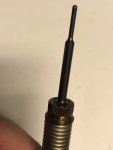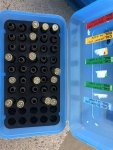All,
I have posted a list (above) of possible causes of failure to fire and light strikes and the solution for each.
In general, we have found that most of the light strike issues have been caused by improper assembly of the striker mechanism. See the attached drawing.
When re-assembling the striker mechanism, it is imperative that the castle nut be screwed down onto the firing pin (striker) so that the
MINIMUM distance between the tip of the firing pin and the forward face of the castle nut is 1.335 inches. Measure this carefully.
When reassembling the striker mechanism, make sure to push the lock washer down against the firing pin until it comes to a stop. This can be difficult because you must push against the striker spring to do it. Two sets of hands makes this much easier so get someone to help you with this and make sure that you are both wearing eye protection. Working with springs can be dangerous.
After your bolt has been fully assembled, the tip of the firing pin should protrude from the face of the bolt by 0.035 - 0.045 inches.
If your problems persist, please send us an email with NUCLEUS LIGHT STRIKES in the subject line and your contact information. We will call you. If we think we cannot resolve the issue over the phone, we will ask you to send your action and trigger to us.
Thus far, in every instance of a customer sending a "light striking" Nucleus action to back to us, we have found that the the light strikes were the result of something that the customer had done improperly. Nevertheless, we give the customer the benefit of the doubt because we understand that exactly replicating the condition within which he experienced the problem is impossible. So if we encounter an instance where we cannot get reliable ignition, there are measures we can take to correct the problem. Among these are the installation of the firing pin having a smaller tip radius than that of our standard pin and the installation of a 25 pound spring, due to arrive at our facility in about two weeks.
The Nucleus was tested using 16 pound springs and CCI number 34 and number 41 primers. The tests were conducted in January of 2018 at a temperature in the low 40s. Since most customers who have replaced their 16 pound spring with a 19 pound spring indicate that they could notice a difference in the effort required to cock the action, I think that sending making a free 25 pound spring available to everyone who has either a Nucleus or a John Hancock may help resolve any lingering issues.
Also, I realize that disassembling the striker mechanism using the large washer that we provide with the action is difficult so are offering a striker assembly tool that will make the job much easier. This can be ordered from our website very soon. See pic below.
I this helps.
Ted



